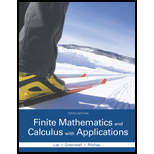
Concept explainers
Determine whether each of the following statements is true or false, and explain why.
1. The indefinite
Whether the given statement is true or not.
Answer to Problem 1RE
The given statement is true.
Explanation of Solution
Given:
“The indefinite integral is another term for the family of all anti-derivatives of a function”.
Definition used:
Anti-derivative:
“The reverse process of obtaining the derivative is called anti-differentiation.
That is,
Description:
Suppose
By anti-derivative definition,
Integrate the expression
That is,
This implies,
Thus, the family of all anti-derivatives of the function is the indefinite integral.
Want to see more full solutions like this?
Chapter 15 Solutions
Finite Mathematics and Calculus with Applications (10th Edition)
- Algebra & Trigonometry with Analytic GeometryAlgebraISBN:9781133382119Author:SwokowskiPublisher:Cengage

 Elementary Linear Algebra (MindTap Course List)AlgebraISBN:9781305658004Author:Ron LarsonPublisher:Cengage Learning
Elementary Linear Algebra (MindTap Course List)AlgebraISBN:9781305658004Author:Ron LarsonPublisher:Cengage Learning 
 College Algebra (MindTap Course List)AlgebraISBN:9781305652231Author:R. David Gustafson, Jeff HughesPublisher:Cengage Learning
College Algebra (MindTap Course List)AlgebraISBN:9781305652231Author:R. David Gustafson, Jeff HughesPublisher:Cengage Learning College AlgebraAlgebraISBN:9781305115545Author:James Stewart, Lothar Redlin, Saleem WatsonPublisher:Cengage Learning
College AlgebraAlgebraISBN:9781305115545Author:James Stewart, Lothar Redlin, Saleem WatsonPublisher:Cengage Learning





